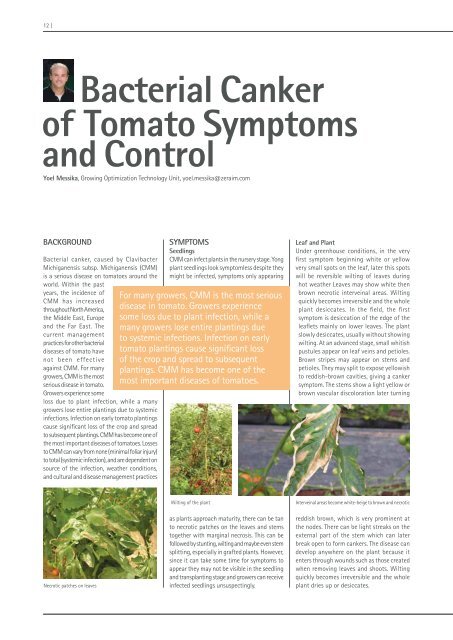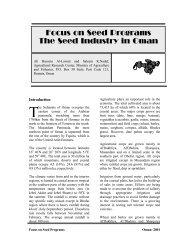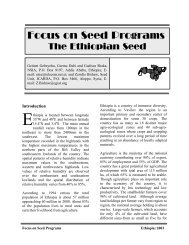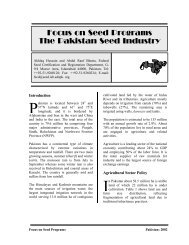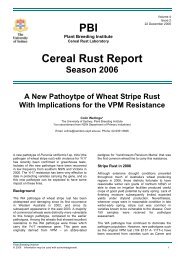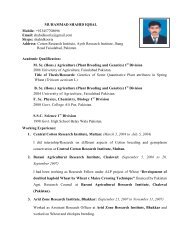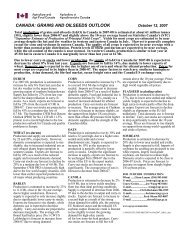Download newsletter - SeedQuest
Download newsletter - SeedQuest
Download newsletter - SeedQuest
Create successful ePaper yourself
Turn your PDF publications into a flip-book with our unique Google optimized e-Paper software.
12 |<br />
Bacterial Canker<br />
of Tomato Symptoms<br />
and Control<br />
Yoel Messika, Growing Optimization Technology Unit, yoel.messika@zeraim.com<br />
BACKGROUND<br />
Bacterial canker, caused by Clavibacter<br />
Michiganensis subsp. Michiganensis (CMM)<br />
is a serious disease on tomatoes around the<br />
world. Within the past<br />
years, the incidence of<br />
CMM has increased<br />
throughout North America,<br />
the Middle East, Europe<br />
and the Far East. The<br />
current management<br />
practices for other bacterial<br />
diseases of tomato have<br />
not been effective<br />
against CMM. For many<br />
growers, CMM is the most<br />
serious disease in tomato.<br />
Growers experience some<br />
loss due to plant infection, while a many<br />
growers lose entire plantings due to systemic<br />
infections. Infection on early tomato plantings<br />
cause significant loss of the crop and spread<br />
to subsequent plantings. CMM has become one of<br />
the most important diseases of tomatoes. Losses<br />
to CMM can vary from none (minimal foliar injury)<br />
to total (systemic infection), and are dependent on<br />
source of the infection, weather conditions,<br />
and cultural and disease management practices<br />
SYMPTOMS<br />
Seedlings<br />
CMM can infect plants in the nursery stage. Yong<br />
plant seedlings look symptomless despite they<br />
might be infected, symptoms only appearing<br />
For many growers, CMM is the most serious<br />
disease in tomato. Growers experience<br />
some loss due to plant infection, while a<br />
many growers lose entire plantings due<br />
to systemic infections. Infection on early<br />
tomato plantings cause significant loss<br />
of the crop and spread to subsequent<br />
plantings. CMM has become one of the<br />
most important diseases of tomatoes.<br />
Leaf and Plant<br />
Under greenhouse conditions, in the very<br />
first symptom beginning white or yellow<br />
very small spots on the leaf, later this spots<br />
will be reversible wilting of leaves during<br />
hot weather Leaves may show white then<br />
brown necrotic interveinal areas. Wilting<br />
quickly becomes irreversible and the whole<br />
plant desiccates. In the field, the first<br />
symptom is desiccation of the edge of the<br />
leaflets mainly on lower leaves. The plant<br />
slowly desiccates, usually without showing<br />
wilting. At an advanced stage, small whitish<br />
pustules appear on leaf veins and petioles.<br />
Brown stripes may appear on stems and<br />
petioles. They may split to expose yellowish<br />
to reddish-brown cavities, giving a canker<br />
symptom. The stems show a light yellow or<br />
brown vascular discoloration later turning<br />
Wilting of the plant<br />
Interveinal areas become white-beige to brown and necrotic<br />
Necrotic patches on leaves<br />
as plants approach maturity, there can be tan<br />
to necrotic patches on the leaves and stems<br />
together with marginal necrosis. This can be<br />
followed by stunting, wilting and maybe even stem<br />
splitting, especially in grafted plants. However,<br />
since it can take some time for symptoms to<br />
appear they may not be visible in the seedling<br />
and transplanting stage and growers can receive<br />
infected seedlings unsuspectingly.<br />
reddish brown, which is very prominent at<br />
the nodes. There can be light streaks on the<br />
external part of the stem which can later<br />
break open to form cankers. The disease can<br />
develop anywhere on the plant because it<br />
enters through wounds such as those created<br />
when removing leaves and shoots. Wilting<br />
quickly becomes irreversible and the whole<br />
plant dries up or desiccates.


